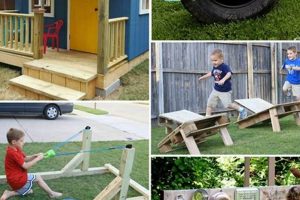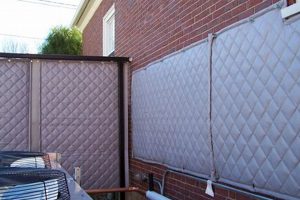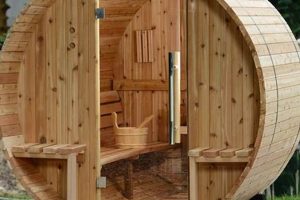The concept entails constructing a washing station situated in an external setting, typically adjacent to gardens, patios, or outdoor kitchens. These projects often repurpose existing materials or utilize readily available components to create a functional fixture for tasks such as cleaning produce, washing hands, or general outdoor cleanup.
Implementing such a fixture enhances outdoor living spaces by providing convenient access to water and drainage, thereby minimizing the transfer of dirt and debris into indoor areas. Historically, outdoor sinks have served as essential features in agricultural and rural settings, facilitating hygiene and sanitation practices. Modern interpretations extend this utility to recreational and domestic environments.
The subsequent sections will explore specific design considerations, material options, and construction techniques relevant to creating a personalized and effective outdoor washing solution.
Essential Considerations for Outdoor Washing Stations
Successful implementation requires careful planning and execution. The following guidelines address key aspects of the construction and integration process.
Tip 1: Location Assessment: Analyze the intended placement in relation to existing plumbing lines. Proximity to water sources and drainage systems minimizes installation complexity and cost. Consider sunlight exposure to prevent algae growth and freezing temperatures that could damage pipes.
Tip 2: Material Selection: Opt for weather-resistant materials such as stainless steel, treated lumber, or concrete. These choices withstand exposure to the elements and resist corrosion, ensuring longevity and minimizing maintenance. Salvaged materials may offer cost savings, but require thorough inspection and preparation.
Tip 3: Plumbing Integration: Consult local building codes and regulations regarding plumbing connections. Proper installation of drainage traps and backflow preventers is crucial to prevent contamination and ensure compliance. Consider the use of frost-proof faucets in colder climates.
Tip 4: Structural Stability: Ensure the frame and base provide adequate support for the sink basin and any countertop elements. Utilize sturdy joinery techniques and appropriate fasteners to prevent instability or collapse under load. Consider adding cross bracing for enhanced rigidity.
Tip 5: Drainage Considerations: Plan for efficient water runoff. Connect the drain to an existing sewer line, septic system, or create a designated drainage area. Proper grading and the use of gravel or permeable materials prevent water accumulation and soil erosion.
Tip 6: Faucet Selection: Choose a faucet designed for outdoor use with UV resistance and freeze-proof features. Consider functionality, such as a pull-down sprayer for versatile cleaning or a hands-free sensor for enhanced hygiene. Ensure compatibility with the water pressure available at the chosen location.
Tip 7: Countertop Material: For work surfaces, concrete, tile, or sealed wood offer durability and aesthetic appeal. Apply a sealant to protect against moisture and staining. Ensure the countertop is properly supported and level for stable use.
Achieving a functional and durable outdoor washing station hinges on careful planning and attention to detail. These considerations ensure the resulting fixture seamlessly integrates into the outdoor environment and provides years of reliable service.
Subsequent sections will address common challenges and troubleshooting strategies encountered during the construction process.
1. Location
The selection of a suitable location constitutes a foundational decision in the successful implementation. The chosen site directly influences the functionality, cost, and long-term usability. Overlooking this initial phase can result in complications during installation and diminished overall effectiveness.
- Proximity to Plumbing
Optimum placement minimizes the distance to existing water supply and drainage lines. Longer runs of piping increase material costs and labor, and can also reduce water pressure. Positioning the installation near a pre-existing outdoor faucet or sewer connection simplifies the plumbing process and reduces the likelihood of regulatory compliance issues.
- Accessibility and Convenience
The chosen location should be easily accessible from the areas where the sink will be primarily used, such as gardens, patios, or outdoor kitchens. An inconveniently located fixture discourages frequent use and defeats the purpose of adding an outdoor washing station. Consider foot traffic patterns and potential obstructions when selecting the site.
- Environmental Factors
Exposure to direct sunlight, freezing temperatures, and excessive wind can impact the longevity and functionality. Sites with prolonged sun exposure may promote algae growth in the sink basin and require UV-resistant materials. In colder climates, a location protected from wind and frost is crucial to prevent pipe freezing. Proximity to trees can result in falling leaves and debris clogging the drain, necessitating regular maintenance.
- Surface and Support
The ground surface must provide a stable and level foundation for the sink structure. Uneven surfaces can lead to instability and potential structural failure. Consider the soil composition and drainage characteristics to prevent water accumulation around the base of the installation. A concrete pad or compacted gravel base can provide a solid and well-drained foundation.
The aforementioned considerations highlight the critical role of location in ensuring the practicality and durability. A carefully selected site, with attention to plumbing access, convenience, environmental factors, and structural support, significantly contributes to the overall success and longevity of the outdoor washing solution.
2. Materials
The selection of appropriate materials directly impacts the longevity, functionality, and aesthetic appeal of any outdoor washing station. Careful consideration of environmental factors, structural requirements, and maintenance demands is essential for a successful and durable outcome.
- Sink Basin Composition
Stainless steel, concrete, and composite materials are commonly employed. Stainless steel offers excellent corrosion resistance and ease of cleaning, while concrete provides a robust and customizable aesthetic. Composite sinks offer a balance of durability and affordability. The chosen material must withstand prolonged exposure to moisture, UV radiation, and temperature fluctuations.
- Frame Construction Materials
Treated lumber, metal framing, and masonry are viable options for supporting the sink basin and associated plumbing. Treated lumber resists rot and insect infestation, making it suitable for outdoor environments. Metal framing provides superior strength and durability, while masonry offers a permanent and aesthetically pleasing solution. Structural integrity is paramount to prevent collapse or instability.
- Plumbing Components
Copper, PVC, and PEX piping are typically utilized for water supply and drainage. Copper offers superior durability and resistance to extreme temperatures, but is more expensive and requires specialized installation techniques. PVC is a cost-effective and readily available option, but is susceptible to damage from freezing temperatures. PEX offers flexibility and freeze resistance, making it a suitable alternative to copper in colder climates. Adherence to local plumbing codes is mandatory.
- Countertop Surface Selection
Concrete, tile, and sealed wood are popular choices for countertop surfaces. Concrete provides a durable and customizable surface, while tile offers a wide range of aesthetic options and is resistant to staining. Sealed wood offers a natural and aesthetically pleasing surface, but requires regular maintenance to prevent water damage. The surface must be non-porous and resistant to scratching and staining.
The interplay between these material choices defines the overall performance and longevity. The selection process should prioritize durability, weather resistance, and ease of maintenance, while also considering aesthetic preferences and budgetary constraints. Prior planning and informed decision-making are critical for achieving a functional and visually appealing outdoor washing station that withstands the rigors of the outdoor environment.
3. Plumbing
A functional outdoor washing station critically depends on effective plumbing. The presence or absence of a properly installed plumbing system directly determines the utility and convenience. Without suitable water supply and drainage, the fixture becomes a mere decorative element. For instance, failure to connect to a water source renders the sink unusable, while insufficient drainage leads to water accumulation, creating unsanitary conditions and potential soil erosion.
Integration requires adherence to local plumbing codes and regulations. This includes the use of appropriate materials, such as PVC or PEX piping, and the correct installation of backflow preventers to protect the potable water supply. Incorrect plumbing can lead to leaks, low water pressure, or even contamination of the water source. A common example is the improper connection to a septic system, which can result in sewage backups and environmental hazards. Frost-free hose bibs are required in colder climates to prevent burst pipes during freezing temperatures.
In summary, plumbing is not merely an ancillary component; it constitutes the core functionality. Proper installation ensures convenience, hygiene, and compliance with regulations. Neglecting this aspect undermines the entire purpose and can lead to costly repairs and potential health risks. Therefore, comprehensive planning and execution, potentially involving a qualified plumber, is paramount for a successful and sustainable outdoor washing station.
4. Drainage
Effective water removal is paramount to the functionality and longevity of any outdoor washing station. Improper drainage can lead to a range of issues, from unsanitary conditions to structural damage, rendering the fixture unusable and potentially creating environmental hazards. Thus, drainage deserves careful consideration during the design and construction phases.
- Sewer Connection
Direct connection to a municipal sewer system provides the most reliable and sanitary method of wastewater disposal. This approach requires compliance with local plumbing codes and may necessitate permits. The cost of connection can be significant, but it eliminates the need for alternative drainage solutions and ensures proper treatment of wastewater. Direct sewer connections are particularly important in areas with strict environmental regulations.
- Greywater Systems
Utilizing a greywater system allows for the reuse of water for irrigation purposes. This approach reduces water consumption and minimizes the environmental impact. However, greywater systems require careful design and maintenance to prevent clogging and bacterial contamination. The water must be filtered and treated before being used for irrigation, and certain soaps and detergents should be avoided. Local regulations governing greywater systems vary widely.
- Dry Wells
A dry well provides an underground storage area for wastewater, allowing it to slowly percolate into the surrounding soil. This approach is suitable for situations where sewer connections are unavailable or impractical, and greywater systems are not desired. The effectiveness of a dry well depends on the soil’s permeability and the volume of wastewater generated. Proper construction and maintenance are essential to prevent soil contamination and groundwater pollution. Dry wells may be subject to local regulations.
- French Drains
A French drain consists of a trench filled with gravel and a perforated pipe, allowing water to drain away from the washing station. This approach is suitable for diverting surface water and preventing water accumulation around the base of the fixture. French drains are relatively simple to construct and require minimal maintenance. However, they are not designed to handle large volumes of wastewater and are not a substitute for a proper drainage system.
In conclusion, effective water management is a critical element in the creation of a functional and sustainable outdoor washing station. The chosen drainage method should align with local regulations, environmental considerations, and the specific needs of the installation. A well-designed and properly implemented drainage system ensures the longevity of the fixture and protects the surrounding environment from contamination.
5. Durability
The correlation between structural integrity and long-term serviceability is fundamental when considering a self-constructed outdoor washing area. Exposure to weather, temperature fluctuations, and frequent use necessitate the selection of robust materials and construction methods. Premature failure due to material degradation or structural weakness negates the cost savings associated with a do-it-yourself approach and can result in costly repairs or complete replacement. Examples include untreated wood warping and rotting, inadequate sealing leading to water damage, or thin-gauge metal components corroding rapidly.
The operational lifespan is directly proportional to the quality of materials and the precision of construction techniques. For instance, employing pressure-treated lumber for framing, coupled with stainless steel fasteners, significantly enhances resistance to moisture and decay, extending the overall lifespan. Similarly, using a properly sealed concrete countertop minimizes the risk of staining and cracking from exposure to the elements. A critical factor often overlooked is the integration of frost-proof components in regions subject to freezing temperatures. Failure to account for this leads to pipe bursts and structural damage. Galvanized steel, powder-coated finishes, and UV-resistant plastics represent material choices that actively mitigate degradation caused by environmental factors.
In summary, durability is not merely a desirable attribute but an essential prerequisite for the long-term viability of a DIY outdoor sink. Compromising on material quality or construction precision to reduce initial costs invariably results in diminished lifespan and increased long-term expenses. The application of sound engineering principles, informed material selection, and meticulous construction techniques are paramount to achieving a robust and dependable outdoor washing solution.
6. Functionality
The practicality of a self-constructed outdoor washing station hinges on its intended utility. The level of functionality dictates design choices, material selection, and plumbing configurations. A station intended solely for handwashing requires fewer features than one purposed for cleaning garden produce or preparing food. The degree of functionality also impacts the complexity of the project, influencing construction time and overall cost. A simple handwashing station may suffice for basic needs, whereas a more elaborate setup equipped with hot water and multiple basins enhances versatility.
Consider, for example, a gardening enthusiast who regularly cleans harvested vegetables. A high-functionality station might include a large basin, a sprayer nozzle for rinsing, and a durable countertop for food preparation. Conversely, a station primarily intended for rinsing muddy boots necessitates a rugged construction, a wide basin to accommodate large items, and a simple drainage system. The specific tasks intended for the outdoor sink directly correlate with its essential features. An outdoor bar setup may require functionality like a built-in ice chest or bottle opener, while a simple utility sink may only need cold water and a basic drainage system.
Ultimately, the success hinges on defining intended uses upfront. A clear understanding of the functional requirements ensures that design and construction choices align with user needs, resulting in a practical and valuable addition to outdoor spaces. Misalignment between functionality and design leads to a station that is either underutilized or incapable of meeting its intended purpose, thereby diminishing its overall value.
7. Aesthetics
The visual integration of a self-constructed outdoor washing station with its surroundings directly influences its perceived value and overall satisfaction. While functionality remains paramount, the aesthetic qualities contribute significantly to the harmonious blending of the fixture within the existing landscape or architectural design. A poorly designed or visually incongruous structure detracts from the overall appeal of the outdoor space, diminishing its value. Conversely, a well-designed and visually appealing station enhances the aesthetic qualities of the surrounding area, adding value and creating a more inviting environment. For example, a rustic-style washing station constructed from reclaimed wood can complement a cottage garden, while a sleek, modern design featuring stainless steel and concrete integrates seamlessly with a contemporary patio.
The material selection, color palette, and overall design contribute to the aesthetic impact. Incorporating elements that echo existing design themes creates a cohesive and visually pleasing effect. The integration of decorative elements, such as potted plants or integrated lighting, further enhances the visual appeal. The choice of sink basin style, faucet design, and countertop material also impacts the aesthetic outcome. For instance, an ornate ceramic basin paired with a vintage-style faucet can create a charming and nostalgic effect, while a minimalist stainless steel basin and faucet contribute to a clean and modern aesthetic. Attention to detail, such as the careful placement of hardware and the precise execution of joinery, further elevates the aesthetic quality.
The aesthetic considerations are not merely superficial; they represent an integral component of a successful build. While functionality dictates the practical aspects of the fixture, aesthetics determine its contribution to the overall ambiance and perceived value of the outdoor space. Achieving a harmonious balance between functionality and aesthetics results in a washing station that is both practical and visually appealing, enhancing the overall outdoor living experience.
Frequently Asked Questions Regarding Self-Constructed Outdoor Washing Stations
The following addresses commonly encountered queries and misconceptions related to the design, construction, and maintenance of DIY outdoor washing stations.
Question 1: Is a building permit necessary for constructing an outdoor washing station?
Building permit requirements vary based on location and the scope of the project. Generally, any structure involving plumbing modifications or connections to existing water or sewer lines necessitates a permit. Consultation with local building authorities is advisable to ensure compliance with applicable regulations.
Question 2: What is the most durable material for an outdoor sink basin?
Stainless steel offers optimal durability for outdoor sink basins due to its resistance to corrosion, staining, and impact damage. Concrete provides a robust alternative, but requires proper sealing to prevent moisture absorption and cracking. Avoid porous materials that are susceptible to freeze-thaw damage.
Question 3: How can freezing pipes be prevented in colder climates?
Insulating exposed pipes with foam sleeves or heat tape provides protection against freezing temperatures. Alternatively, install a frost-free hose bib, which shuts off the water supply inside the heated portion of the building. Ensure adequate drainage to prevent water from accumulating in pipes and freezing.
Question 4: What are the options for wastewater disposal if a sewer connection is unavailable?
Greywater systems offer a sustainable option for reusing wastewater for irrigation purposes, provided they comply with local regulations. Alternatively, a dry well or French drain can facilitate groundwater recharge, but these methods require proper design and maintenance to prevent soil contamination.
Question 5: How should a wooden frame be protected from the elements?
Pressure-treated lumber resists rot and insect infestation, making it a suitable choice for outdoor framing. Apply a sealant or paint to further protect the wood from moisture damage. Regularly inspect the frame for signs of decay and reapply sealant as needed.
Question 6: What factors should be considered when selecting a faucet for outdoor use?
Choose a faucet specifically designed for outdoor use, featuring UV resistance, freeze-proof construction, and durable materials. Consider functionality, such as a pull-down sprayer or hands-free sensor, and ensure compatibility with the available water pressure. Confirm that the faucet complies with lead-free regulations.
Adherence to these guidelines ensures the creation of a functional, durable, and code-compliant outdoor washing solution.
The subsequent section will explore design inspiration and practical examples of various implementations.
Conclusion
This exploration of “diy outdoor sink ideas” has detailed critical aspects, encompassing location assessment, material selection, plumbing integration, structural stability, and drainage considerations. Each element contributes significantly to the functionality, longevity, and code compliance of the finished installation. Overlooking these factors can result in structural deficiencies, plumbing failures, or environmental hazards.
Therefore, meticulous planning, adherence to local building codes, and informed decision-making throughout the construction process are paramount. The creation of a safe, functional, and aesthetically pleasing outdoor washing station requires diligence and a commitment to sound construction practices. A properly executed project enhances outdoor living spaces and provides a valuable and sustainable resource.







